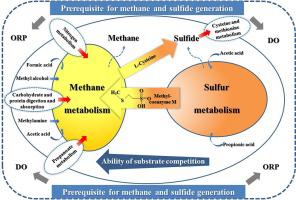当前位置:
X-MOL 学术
›
Environ. Int.
›
论文详情
Our official English website, www.x-mol.net, welcomes your
feedback! (Note: you will need to create a separate account there.)
Symbiosis of sulfate-reducing bacteria and methanogenic archaea in sewer systems
Environment International ( IF 10.3 ) Pub Date : 2020-07-04 , DOI: 10.1016/j.envint.2020.105923 Xuan Shi 1 , Ge Gao 2 , Jiameng Tian 2 , Xiaochang C Wang 3 , Xin Jin 1 , Pengkang Jin 3
Environment International ( IF 10.3 ) Pub Date : 2020-07-04 , DOI: 10.1016/j.envint.2020.105923 Xuan Shi 1 , Ge Gao 2 , Jiameng Tian 2 , Xiaochang C Wang 3 , Xin Jin 1 , Pengkang Jin 3
Affiliation

|
Sulfide and methane emissions always simultaneously exist in natural environment and constitute a major topic of societal concern. However, the metabolic environments between sulfate-reducing bacteria (SRB) and methanogenic archaea (MA) exist a great difference, which seems to be opposite to the coexisting phenomenon. To explore this issue, the comprehensive biofilm structures, substrate consuming and metabolism pathways of SRB and MA were investigated in a case study of urban sewers. The results showed that, due to the stricter environmental requirements of MA than SRB, SRB became the preponderant microorganism which promoted the rapid generation of sulfide in the initial period of biofilm formation. According to a metagenomic analysis, the SRB appeared to be more preferential than MA in sewers, and the preponderant SRB could provide a key medium (Methyl-coenzyme M) for methane metabolism. Therefore, the diversity of MA gradually increased, and the symbiosis system formed preliminarily. In addition, via L-cysteine, methane metabolism also participated in sulfide consumption which was involved in cysteine and methionine metabolism. This phenomenon of sulfide consumption led to the forward reaction of sulfide metabolism, which could promote sulfide generation while stabilizing the pH value (H concentration) and S concentrations which should have inhibited SRB and MA production. Therefore, the heavily intertwined interactions between sulfide and methane metabolism provided environmental security for SRB and MA, and completely formed the symbiosis between SRB and MA. Based on these findings, an ecological model involving synergistic mechanism between sulfide and methane generation is proposed and this model can also improve understanding on the symbiosis of SRB and MA in the natural environment.
中文翻译:

下水道系统中硫酸盐还原菌与产甲烷古菌的共生
自然环境中硫化物和甲烷排放始终同时存在,成为社会关注的重大话题。然而,硫酸盐还原菌(SRB)和产甲烷古菌(MA)的代谢环境存在很大差异,这似乎与共存现象相反。为了探讨这个问题,以城市下水道为例,对SRB和MA的综合生物膜结构、底物消耗和代谢途径进行了研究。结果表明,由于MA对环境的要求比SRB更严格,SRB成为生物膜形成初期促进硫化物快速生成的优势微生物。根据宏基因组分析,SRB似乎比MA更优先出现在下水道中,并且占优势的SRB可以为甲烷代谢提供关键介质(甲基辅酶M)。因此,MA的多样性逐渐增强,共生系统初步形成。此外,甲烷代谢还通过L-半胱氨酸参与硫化物的消耗,而硫化物又参与半胱氨酸和蛋氨酸的代谢。这种硫化物消耗现象导致了硫化物代谢的正向反应,可以促进硫化物的生成,同时稳定pH值(H浓度)和S浓度,从而抑制SRB和MA的产生。因此,硫化物与甲烷代谢之间紧密交织的相互作用为SRB和MA提供了环境安全,并完全形成了SRB和MA之间的共生关系。基于这些发现,提出了涉及硫化物和甲烷生成之间协同机制的生态模型,该模型还可以提高对自然环境中SRB和MA共生的理解。
更新日期:2020-07-04
中文翻译:

下水道系统中硫酸盐还原菌与产甲烷古菌的共生
自然环境中硫化物和甲烷排放始终同时存在,成为社会关注的重大话题。然而,硫酸盐还原菌(SRB)和产甲烷古菌(MA)的代谢环境存在很大差异,这似乎与共存现象相反。为了探讨这个问题,以城市下水道为例,对SRB和MA的综合生物膜结构、底物消耗和代谢途径进行了研究。结果表明,由于MA对环境的要求比SRB更严格,SRB成为生物膜形成初期促进硫化物快速生成的优势微生物。根据宏基因组分析,SRB似乎比MA更优先出现在下水道中,并且占优势的SRB可以为甲烷代谢提供关键介质(甲基辅酶M)。因此,MA的多样性逐渐增强,共生系统初步形成。此外,甲烷代谢还通过L-半胱氨酸参与硫化物的消耗,而硫化物又参与半胱氨酸和蛋氨酸的代谢。这种硫化物消耗现象导致了硫化物代谢的正向反应,可以促进硫化物的生成,同时稳定pH值(H浓度)和S浓度,从而抑制SRB和MA的产生。因此,硫化物与甲烷代谢之间紧密交织的相互作用为SRB和MA提供了环境安全,并完全形成了SRB和MA之间的共生关系。基于这些发现,提出了涉及硫化物和甲烷生成之间协同机制的生态模型,该模型还可以提高对自然环境中SRB和MA共生的理解。










































 京公网安备 11010802027423号
京公网安备 11010802027423号